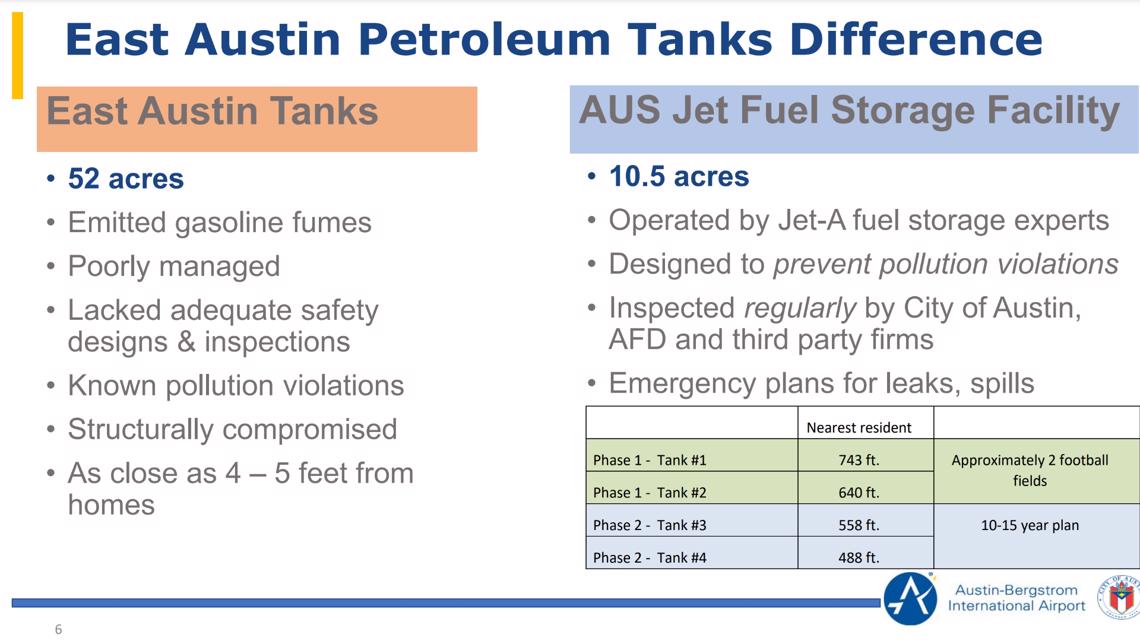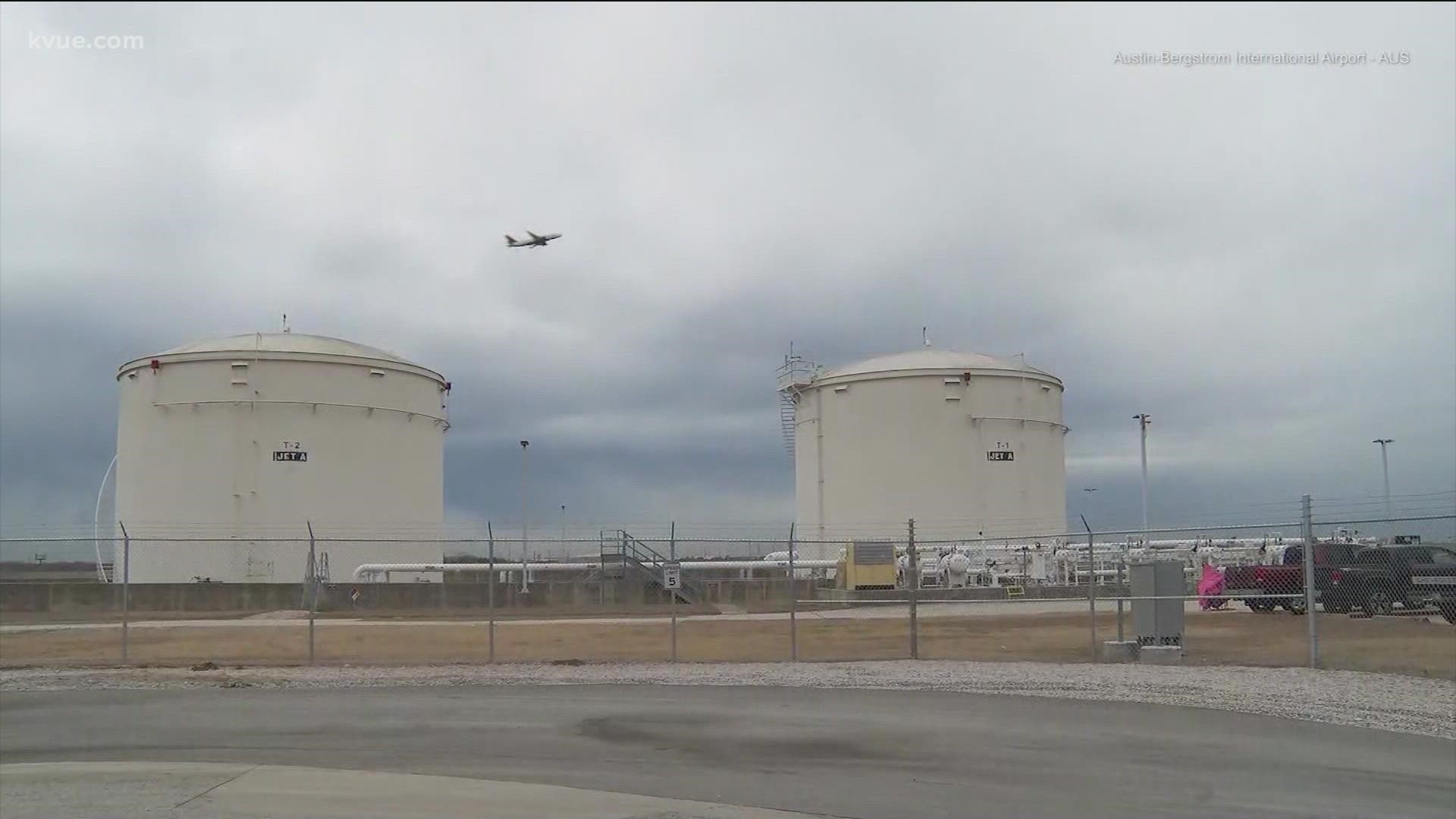AUSTIN, Texas — Austin’s airport is bursting at the seams. Flights are now taking off more often as a record-breaking 20 million fliers are expected this year.
But all those aircraft need fuel – and a lot more than what Austin-Bergstrom International Airport (AUS) has to offer.
Currently, two 1.5-million-gallon tanks are planned on the west side of AUS, next to US 183, and across the highway from a neighborhood where residents are concerned about their health and the process that the City followed in selecting the new site.
Construction of the new facility was supposed to start this spring but is on hold because of the neighbors' concerns. Construction is expected to take up to two years.
The Austin City Council voted Thursday – 5-5 with Natasha Harper-Madison off the dais – to move forward with the facility. Without a majority, an item from District 2 Councilmember Vanessa Fuentes asking airport leaders to find at least three other potential locations for the jet fuel facility and restart the environmental approval process did not pass.
If the council had decided to delay the fuel tank project and restart the site selection process, Airport CEO Jacqueline Yaft told the council during a work session on Tuesday that it could delay the project by at least 2.5 years and put the airport at risk of not being able to serve the current flight schedule or any new flights.
The current fuel facility, which has been within about 1,500 feet of the Barbara Jordan Terminal since 1999, has not experienced any safety issues. Yaft said no fuel spills have ever been reported in the current location. An Austin Fire Department lieutenant said fuel has leaked in the containment pools in the past, but no more than 20 gallons and it is cleaned up using cat litter.
The concrete containment pool, similar to a swimming pool, sits under the current tanks. It has rocks and fabric lining to help mitigate the impacts of any potential leaks.
“My concerns lie with my community who live so closely to the airport, wanting to ensure that the process in which the fuel site location was conducted is one that is done with equity in mind and one that is thorough and communicative in a culturally responsive way,” said Councilmember Fuentes, who represents the area where the airport is located.
When speaking to the council this week, she said this measure is an opportunity to correct the City's history of environmental racism.
During the work session, some council members and Mayor Steve Adler expressed support for the idea of some sort of voluntary buyout program to help concerned neighbors leave the area across the highway from the facility. But Yaft said that's not something airport funds could support, while Councilmember Ann Kitchen asked about the possibility of City funds going toward that.
The airport hired a third-party contractor to evaluate different sites on airport property as potential fuel facility locations. The selected site is the only viable option, according to a memo Yaft wrote to Adler and council members last month.
Some of the other locations evaluated were between 727 and 1,977 feet from other residences, according to the airport's presentation.
Some have compared the new fuel farm to the 52-acre East Austin petroleum tanks, which emitted gasoline fumes and lacked adequate safety designs and inspections, according to a presentation from the airport. The new fuel storage facility would be 10.5 acres, operated and managed by Jet-A fuel experts and regularly inspected by the City and Austin Fire Department.


Fire officials told the council that Jet-A fuel is significantly less volatile when compared to gasoline.
Operational impacts
There’s a lot at stake for the region’s economy and continued growth at AUS the longer the fuel facility project is delayed. New analyses have shown AUS is the fastest-growing airport in America based on new flights added and passenger volume in the last six months, the airport's Chief Operating Officer Ghizlane Badawi told KVUE.
Airlines support the project and want a larger fuel facility to avoid any operational impacts that could negatively affect air service from Austin, KVUE has learned.
American Airlines has significant plans to keep growing in Austin, but a spokesperson for the airline told KVUE the fuel farm issue “raises questions” about the airline’s ability to continue growing without operational impacts. American grew exponentially at AUS over the last year, now with service to 42 destinations and more than 3.2 million Austin fliers in 2021.
In a letter to the council, the Austin Chamber of Commerce wrote that delaying construction of the fuel facility "harms airport operations, tourism, business, and economic opportunity."
"Failure to expand the jet fuel farm facility expeditiously will make it difficult to attract additional routes and flights, particularly new international destinations such as Asia," the letter said. "Expanding to additional routes benefits tourism, business and commerce throughout the Central Texas region."
Last week, Austin’s airport issued a fuel shortage alert when the supply dropped below one day’s worth of fuel. The airport asked airlines to “tanker in” fuel, meaning land at AUS with more than they may need in case there wasn’t enough to fill up in Austin. The alert lasted for two days.
By adding fuel, aircraft fly heavier and airlines must delicately balance any potential operational impacts with getting customers to their destinations on schedule.
Last year, during a fuel shortage alert, three British Airways flights had to divert to Dallas-Fort Worth International Airport during the F1 racing weekend because there wasn’t enough in Austin.
The airport only has the capacity for up to three days' worth of fuel supply, while the industry average is up to seven days' worth.
According to the Chamber, if AUS were to run out of fuel, air travel in Austin could be negatively impacted for up to four days.
The construction of the new facility will be entirely paid for by the airlines, an airport spokesperson said. The cost hasn’t been made public.
Since 2019, there have been a total of 16 fuel alerts issued due to low fuel inventory in Austin: one in 2019, one in 2020, 11 in 2021 and three so far in 2022.
Editor's Note: A previous version of this story said there are two 150-million-gallon tanks planned, but they are two 1.5-million gallon tanks.
PEOPLE ARE ALSO READING:

